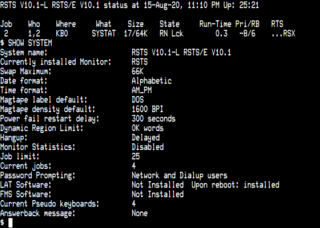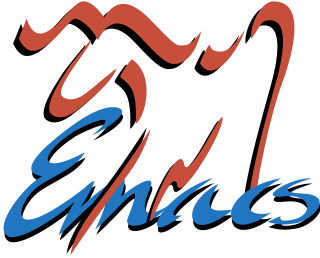Related Research Articles

Cygwin is a Unix-like environment and command-line interface for Microsoft Windows. Cygwin's purpose is expressed in its motto: "Get that Linux feeling – on Windows".
The editor war is the rivalry between users of the Emacs and vi text editors. The rivalry has become an enduring part of hacker culture and the free software community.

A text editor is a type of computer program that edits plain text. Such programs are sometimes known as "notepad" software. Text editors are provided with operating systems and software development packages, and can be used to change files such as configuration files, documentation files and programming language source code.
TECO, short for Text Editor & Corrector, is both a character-oriented text editor and a programming language, that was developed in 1962 for use on Digital Equipment Corporation computers, and has since become available on PCs and Unix. Dan Murphy developed TECO while a student at the Massachusetts Institute of Technology (MIT).

OpenVMS, often referred to as just VMS, is a multi-user, multiprocessing and virtual memory-based operating system. It is designed to support time-sharing, batch processing, transaction processing and workstation applications. Customers using OpenVMS include banks and financial services, hospitals and healthcare, telecommunications operators, network information services, and industrial manufacturers. During the 1990s and 2000s, there were approximately half a million VMS systems in operation worldwide.
In human–computer interaction and user interface design, cut, copy, and paste are related commands that offer an interprocess communication technique for transferring data through a computer's user interface. The cut command removes the selected data from its original position, while the copy command creates a duplicate; in both cases the selected data is kept in temporary storage. The data from the clipboard is later inserted wherever a paste command is issued. The data remains available to any application supporting the feature, thus allowing easy data transfer between applications.

A computer terminal is an electronic or electromechanical hardware device that can be used for entering data into, and transcribing data from, a computer or a computing system. The teletype was an example of an early-day hard-copy terminal and predated the use of a computer screen by decades.

RSTS is a multi-user time-sharing operating system developed by Digital Equipment Corporation for the PDP-11 series of 16-bit minicomputers. The first version of RSTS was implemented in 1970 by DEC software engineers that developed the TSS-8 time-sharing operating system for the PDP-8. The last version of RSTS was released in September 1992. RSTS-11 and RSTS/E are usually referred to just as "RSTS" and this article will generally use the shorter form. RSTS-11 supports the BASIC programming language, an extended version called BASIC-PLUS, developed under contract by Evans Griffiths & Hart of Boston. Starting with RSTS/E version 5B, DEC added support for additional programming languages by emulating the execution environment of the RT-11 and RSX-11 operating systems.

A screen reader is a form of assistive technology (AT) that renders text and image content as speech or braille output. Screen readers are essential to people who are blind, and are useful to people who are visually impaired, illiterate, or have a learning disability. Screen readers are software applications that attempt to convey what people with normal eyesight see on a display to their users via non-visual means, like text-to-speech, sound icons, or a braille device. They do this by applying a wide variety of techniques that include, for example, interacting with dedicated accessibility APIs, using various operating system features, and employing hooking techniques.

In computing, text-based user interfaces (TUI), is a retronym describing a type of user interface (UI) common as an early form of human–computer interaction, before the advent of modern conventional graphical user interfaces (GUIs). Like GUIs, they may use the entire screen area and accept mouse and other inputs. They may also use color and often structure the display using special graphical characters such as ┌ and ╣, referred to in Unicode as the "box drawing" set. The modern context of use is usually a terminal emulator.

Windows Console is the infrastructure for console applications in Microsoft Windows. An instance of a Windows Console has a screen buffer and an input buffer. It allows console apps to run inside a window or in hardware text mode. The user can switch between the two using the Alt+↵ Enter key combination. The text mode is unavailable in Windows Vista and later. Starting with Windows 10, however, a native full-screen mode is available.
ex, short for EXtended, is a line editor for Unix systems originally written by Bill Joy in 1976, beginning with an earlier program written by Charles Haley. Multiple implementations of the program exist; they are standardized by POSIX.
Language-Sensitive Editor (LSE) is a full-screen visual editor for the VAX/VMS and OpenVMS Operating systems. LSE is implemented by using the Text Processing Utility (TPU) language. It is part of the DECset programming tool set, which also contains a test manager, the performance and coverage analyzer (PCA), a code management system (CMS), and a module management mystem (MMS).
VAXELN is a discontinued real-time operating system for the VAX family of computers produced by the Digital Equipment Corporation (DEC) of Maynard, Massachusetts.
EVE is a flexible text editor that is part of the VMS operating system. EVE is implemented by using the Text Processing Utility (TPU).
A console application or command-line program is a computer program designed to be used via a text-only user interface, such as a text terminal, the command-line interface of some operating systems or the text-based interface included with most graphical user interface (GUI) operating systems, such as the Windows Console in Microsoft Windows, the Terminal in macOS, and xterm in Unix.

GNU Emacs is a free software text editor. It was created by GNU Project founder Richard Stallman, based on the Emacs editor developed for Unix operating systems. GNU Emacs has been a central component of the GNU project and a flagship project of the free software movement. Its name has occasionally been shortened to GNUMACS. The tag line for GNU Emacs is "the extensible self-documenting text editor".

Emacs, originally named EMACS, is a family of text editors that are characterized by their extensibility. The manual for the most widely used variant, GNU Emacs, describes it as "the extensible, customizable, self-documenting, real-time display editor". Development of the first Emacs began in the mid-1970s, and work on its direct descendant, GNU Emacs, continues actively; the latest version is 28.2, released in September 2022.
EDT is a character-based text editor from Digital Equipment Corporation (DEC) running on PDP-11, and later for its OpenVMS operating system. It can respond to single keystrokes, and uses function keys to implement commands to the editor. EDT was introduced originally as a line-mode editor. The screen mode was developed first as the Keyboard Editor (KED) on RT-11 as part of the FMS-11 project by Darrell Duffy; EDT on the other operating systems was then enhanced to be compatible with KED.
MICA was the codename of the operating system developed for the DEC PRISM architecture. MICA was designed by a team at Digital Equipment Corporation led by Dave Cutler. MICA's design was driven by Digital's need to provide a migration path to PRISM for Digital's VAX/VMS customers, as well as allowing PRISM systems to compete in the increasingly important Unix market. MICA attempted to address these requirements by implementing VMS and ULTRIX user interfaces on top of a common kernel that could support the system calls, libraries and utilities needed for both environments.
References
- ↑ Guide to the DEC Text Processing Utility
- ↑ "DEC Text Processing Utility Reference Manual". Archived from the original on 2018-05-10. Retrieved 2018-05-09.
- ↑ User's Guide to EVE AA-Z302A-TE. Digital Equipment Corporation. July 1985. p. ix.
- ↑ Gregg Wonderly (September 26, 1988). "v04i092: TPUVI for VMS part 1 of 17". Newsgroup: comp.sources.misc.
- ↑ Gregg Wonderly (July 22, 1987). "VI.RNO - Installation and help for VI emulation in TPU". OpenVMS Freeware CD V5.0. Retrieved July 1, 2022.